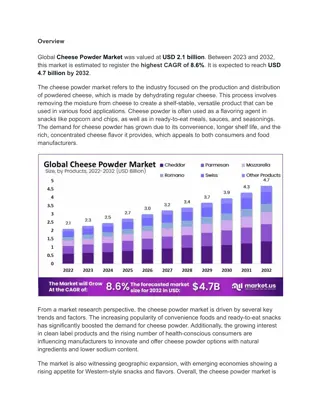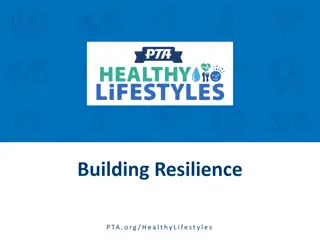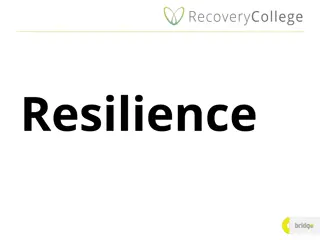
1,3 Propanediol Market Adapts to Market Trends for Increased Resilience
1,3 Propanediol Market size is expected to be worth around USD 1983.2 Mn by 2033, from USD 785.78 Mn in 2023, growing at a CAGR of 9.7% dn
Download Presentation

Please find below an Image/Link to download the presentation.
The content on the website is provided AS IS for your information and personal use only. It may not be sold, licensed, or shared on other websites without obtaining consent from the author. Download presentation by click this link. If you encounter any issues during the download, it is possible that the publisher has removed the file from their server.
E N D
Presentation Transcript
Overview 1,3 Propanediol Market size is expected to be worth around USD 1983.2 Mn by 2033, from USD 785.78 Mn in 2023, growing at a CAGR of 9.7% during the forecast period from 2023 to 2033. The 1,3-propanediol (PDO) market refers to the commercial landscape for a versatile chemical compound used in various industries. PDO is a bio-based chemical commonly derived from renewable resources like corn sugar through fermentation processes. It's a key ingredient in the production of polymers such as polytrimethylene terephthalate (PTT), which is utilized in the textile and plastics industries. Additionally, 1,3-propanediol is used in the formulation of personal care products, cleaning agents, and as a solvent. Its biodegradability and sustainability make it an attractive alternative to petroleum-based chemicals, aligning with the growing consumer and industrial demand for eco-friendly products. The market for 1,3-propanediol is experiencing significant growth driven by several factors. The increasing emphasis on sustainability and the shift towards bio-based products are major catalysts. Companies and consumers alike are seeking greener alternatives, boosting the demand for PDO.
Moreover, advancements in biotechnology have made the production of 1,3-propanediol more cost-effective, enhancing its market competitiveness. The expanding applications in various industries, from textiles to cosmetics, also contribute to its rising market share. As environmental regulations become stricter globally, the 1,3-propanediol market is expected to continue its upward trajectory, offering numerous opportunities for innovation and investment. rk t gm nt By Source Bio-based Petrochemical-based By Application Polytrimethylene Terephthalate Polyurethane Personal Care Detergents Download a sample report in MINUTES@https://market.us/report/1-3-propanediol-market/request-sample/ In 2023, the 1,3 propanediol market was led by the petrochemical-based segment, which held over 61% of the market share. This dominance was due to well-established production processes and extensive infrastructure derived from petroleum derivatives. Additionally, Polytrimethylene Terephthalate (PTT) was a key driver of the market, accounting for over 54.9% of the market share. PTT's popularity in textiles, due to its stretchiness, strength, and resistance to wrinkling, made it the preferred choice for clothing, carpets, and furniture covers. rk t l r DuPont Tate & Lyle Metabolic Explorer
Zhangjiagang Glory Biomaterial Co. Ltd Zouping Mingxing Chemical Co., Ltd. Shell Chemicals LP Merck KGgA Sheng Hong Group Holdings Ltd. Tokyo Chemical Industry Co., Ltd. Primient Haihang Industry Other Key Players Drivers The 1,3 propanediol market is expanding due to rising demand in the textile industry for Polytrimethylene Terephthalate (PTT), valued for its resilience, elasticity, and wrinkle resistance in clothing, carpets, and upholstery. Its versatility in producing durable and efficient Polyurethane for construction, automotive, and furniture industries also boosts demand. Additionally, its moisturizing and soothing properties make it a popular choice in the personal care industry. Environmental awareness further drives market growth, as its biodegradability and eco-friendliness appeal to sustainable consumer preferences. Innovations in production technology enhance efficiency and meet growing application demands. Restraints The market faces challenges like high production costs, particularly for bio-based sources, due to significant initial investments and operational expenses. Compliance with diverse and evolving regulatory standards demands substantial investments and adjustments, adding operational burdens. Feedstock availability for bio-based production is inconsistent,
relying on renewable sources like corn or sugar, which are affected by crop yields, geographical restrictions, and food source competition. The presence of alternative materials and technological limitations in scaling up bio-based production also pose significant hurdles, impacting market competitiveness and growth potential. Opportunities Opportunities in the 1,3 propanediol market include exploring alternative renewable feedstocks, enhancing sustainability and reducing agricultural resource reliance. Advancements in production technologies can increase efficiency, decrease costs, and improve scalability for both petrochemical and bio-based production. Strategic collaborations among industry stakeholders can accelerate innovation and address challenges. Expanding applications in emerging sectors like renewable energy, pharmaceuticals, and bioplastics, alongside rising demand for eco-friendly products, present significant growth potential. Targeting untapped markets in developing regions offers additional avenues for market expansion and diversification. Challenges Challenges include high production costs, especially for bio-based 1,3 propanediol, due to substantial initial and ongoing expenses. Navigating complex regulatory standards and compliance across regions adds significant operational burdens. Consistent feedstock availability for bio-based production is hindered by crop yield variations and competition with food sources. The competitive landscape with alternative materials and technological limitations in scaling up bio-based production processes further impact market growth. Addressing these challenges requires efforts in cost optimization, regulatory adaptation, securing reliable feedstocks, fostering technological innovations, and effectively positioning 1,3 propanediol in a competitive market.






















